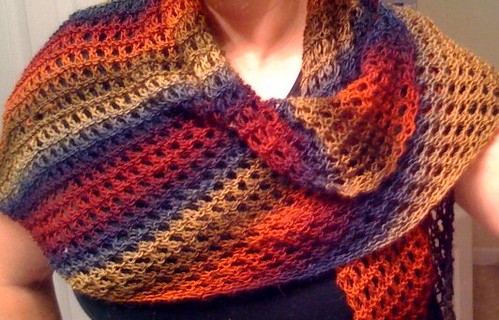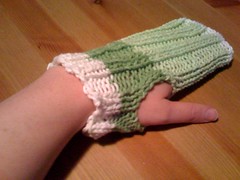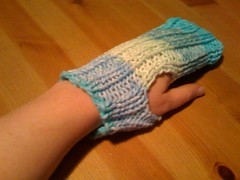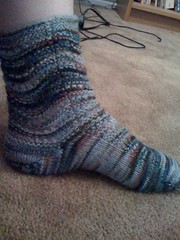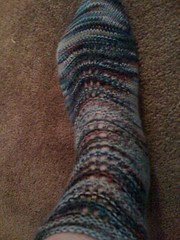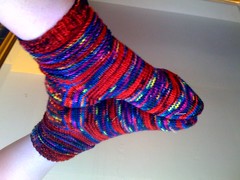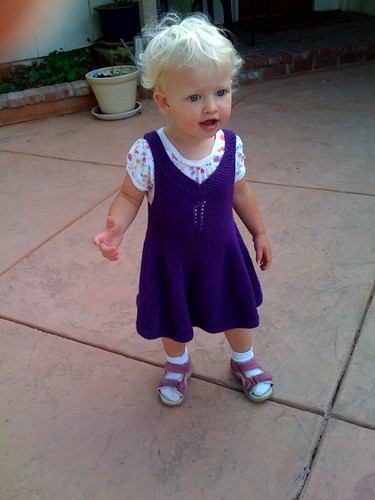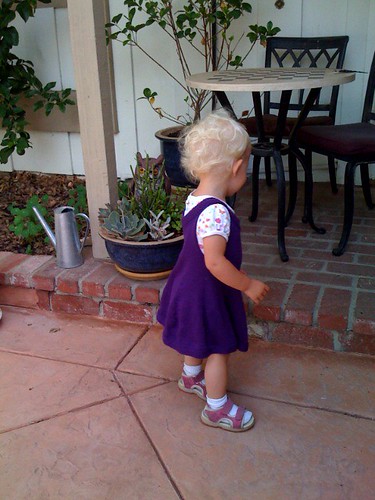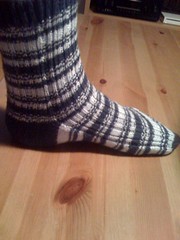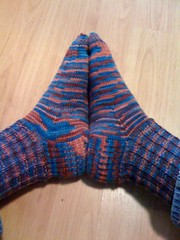
This sock is constructed from the top down with a ribbed cuff and heel flap. Pillars of knit stitches are set against a background of reverse stockinette on the leg, and the foot is simple, speedy stockinette. It was designed to be very easy to pick and up put down during the unpredictable breaks in my jury duty service without needing to refer to a pattern. Also, the inexpensive price of Knit Picks Essential will let you buy yarn for a pair of these socks with even a meager jury duty reimbursement.
MaterialsNeedles: Set of 4 doublepointed needles, size 2 (or size needed to obtain gauge - I am a pretty tight knitter, so you may get a better fitting sock on a size 1 needle)
Tapestry needle
Yarn: Any sock/fingering weight yarn will work for this pattern. Sample shown uses Knit Picks Essential Multi, 2 skeins (about 340 yards)
Gauge: 7 stitches per inch in stockinette stitch (for a comfy leg - try 7.5 stitches to the inch for a snugger fit)
Size: Women’s medium
CuffUsing long tail cast on, cast on 64 stitches. Join to work in the round, taking care not to twist stitches. Tail from cast on will serve as a marker for the beginning of the round. Arrange on three double-pointed needles as follows:
Needle 1: 16 stitches
Needle 2: 16 stitches
Needle 3: 32 stitches
Work K1, P1 ribbing for 12 rounds (or desired cuff length).
Leg*K1, P3*, repeat to end of round. Repeat this row until leg measures 6 3/4 inches from cast-on cuff edge or desired length of leg.
HeelHeel flap is worked back and forth on the 32 stitches on Needle 3. The stitches on Needles 1 and 2 form the instep and will rest while the heel is fashioned.
Turn the work to begin working the heel on the wrong side of needle 3.
Row 1 (WS): Slip 1 purlwise with yarn in front, purl to end of row
Row 2 (RS): *Slip 1 purlwise with yarn in back, K1*, repeat to end of row
Repeat these two rows 15 times. Repeat Row 1 once more.
Heel turn begins on the right side of the work and incorporates short rows to form the three-dimensional heel.
Row 1 (RS): Slip 1, K16, ssk, K1, turn.
Row 2 (WS): Slip 1, P3, P2tog, P1, turn.
Note the gap that is evident between the unworked stitches on the needle and the last worked stitch in the short rows.
Row 3 (RS): Slip 1, K to one stitch before the gap, ssk, K1, turn.
Row 4 (WS): Slip 1, P to one stitch before the gap, p2tog, p1, turn.
Repeat Rows 3 and 4 until all heel stitches have been worked. Knit across all stitches.
Gusset and FootRearrange stitches as follows. Slip half of the heel stitches from Needle 1 to free needle. Slip instep stitches from Needle 3 to Needle 2. Needle 2 now has 32 stitches.
Beginning with Needle 1, which has half of the heel stitches, pick up 16 stitches along the heel flap. Work across Needle 2 in stockinette stitch. With a free needle, pick up 16 stitches along the heel flap and knit across the remaining heel stitches.
Needle 1 now holds half of the foot stitches, Needle 2 has the instep stitches, and Needle 3 holds the other half of the foot stitches. Beginning of round is at center bottom of foot.
Gusset Row 1: Knit to last three stitches on Needle 1, K2tog, K1. Knit across Needle 2. K1, ssk, knit to end of Needle 3.
Gusset Row 2: Work even.
Repeat these two rows until there are 16 stitches on Needles 1 and 3.
Work even until foot is 2 inches shorter than desired length.
ToeToe Row 1: Knit to last three stitches on Needle 1, K2tog, K1. K1, ssk, knit to last 3 stitches on Needle 2, K2tog, K1. K1, ssk, knit to end of Needle 3.
Toe Row 2: Work even.
Repeat these two rows until there are 24 stitches remaining. Knit stitches on Needle 1 to bring yarn to side of toe for finishing.
FinishingSlip stitches from Needle 3 to Needle 1. Use kitchener stitch to join toe stitches together. Break yarn. Weave in ends
OR
Turn sock inside out. Slip stitches from Needle 3 to Needle 1. Use three needle bindoff to join stitches on needles 1 and 2. Break yarn. Weave in ends.



